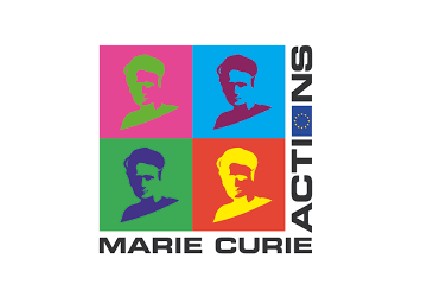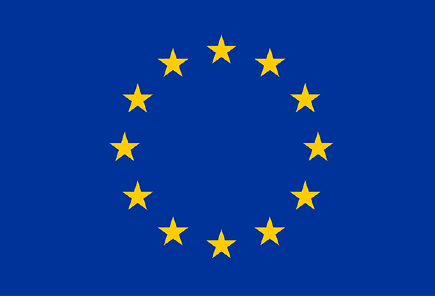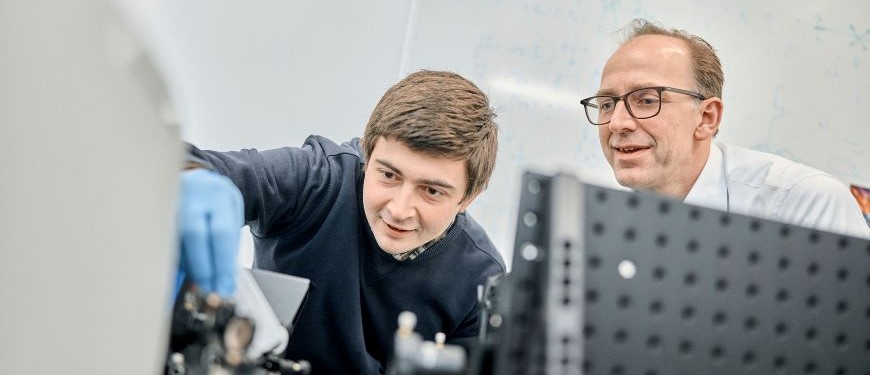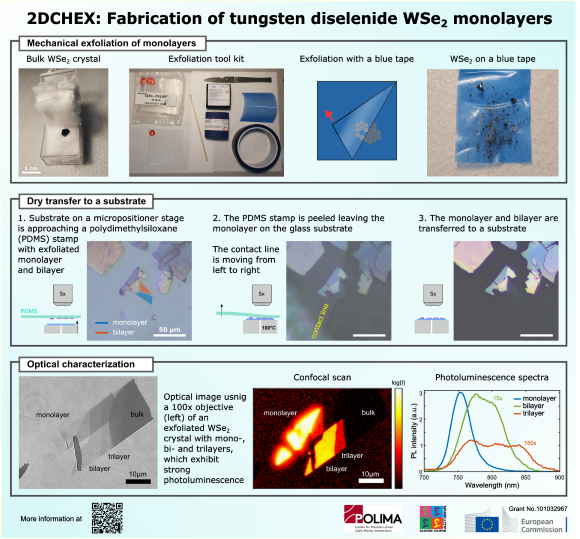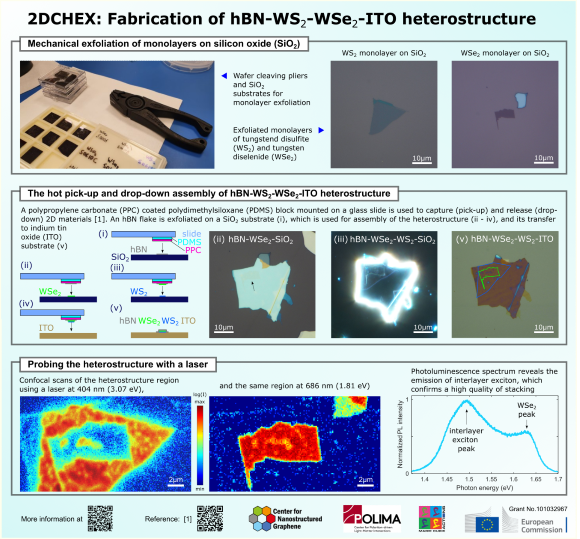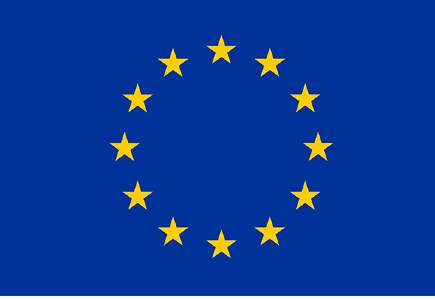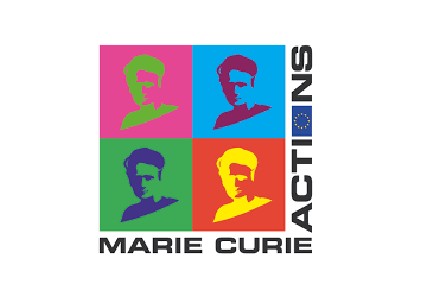The ambition of this MSCA Individual Fellowship (2DCHEX - 2D CHarged EXcitons) was to exploit charged excitonic states in TMD monolayers to tackle the valley depolarization and enable the remarkable features at room temperature. This functionality holds great potential for quantum technologies capable of boosting information processing and computation abilities beyond our imagination. In a broader perspective, such devices could replace current classical informational and computing technologies, effectively impacting everyone who uses a computer or a smartphone today. Quantum room-temperature opto-valleytronic devices have the potential to revolutionize the security of our communication and enable exponentially more powerful computational capabilities.
The proposed idea within the 2DCHEX project was to develop an approach for inducing charged excitonic states in TMD monolayer. Electrochemical charging has been suggested here for the ultimate control of charged excitons and their emission properties, since such an approach provided the highest attainable electron doping levels in comparison with optical, electrostatic, chemical, or mechanical doping approaches. Via controlling the charging state of an exciton one could influence the temperature-dependent parasitic processes by boosting the emission rate and charge-screening the valley depolarization.
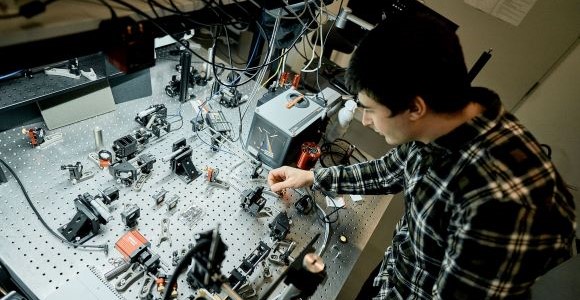
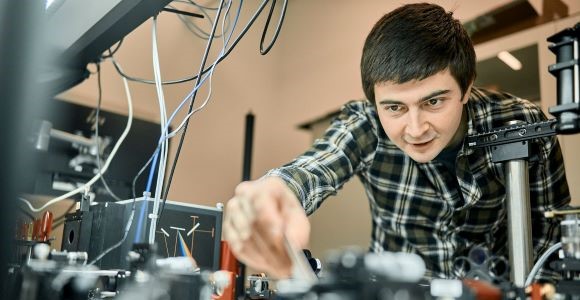
More information about the project
The work performed in the 2DCHEX project was centered around the following key aspects:
- Fabrication of TMD monolayers and characterization of their photoluminescence properties at room temperature. During the secondment at DTU Sergii Morozov learned the state-of-the-art techniques of TMD monolayer fabrication and used these skills for fabrication of samples at the host institution (mechanical exfoliation, dry transfer, and assembly of van-der-Waals heterostructures). Experimental setups for laser excitation of TMD monolayers and characterization of generated photoluminescence (spectral properties, polarization response, time dynamics) were designed and built. While testing the experimental setups with a colloidal quantum dot (0D system), a spectral filtering technique which purifies single photon emission at room temperature was developed. The results were published in Nanoscale.
- Development of electrochemical electron-doping technique suitable for TMD monolayers to manipulate the exciton charging and its optical response. Sergii Morozov designed a custom-built electrochemical cell which could control the formation of charged excitons in various TMD monolayers (WS2, WSe2, MoSe2) and described its operational principle (he discovered that the ionization dynamics of the neutral exciton follows the temperature dependent Fermi-Dirac distribution, which interestingly allowed him to quantify the position of Fermi level and electron doping densities). It was demonstrated that the electrochemical doping provides the highest doping densities among all the doping techniques available for TMD monolayers, which unlocks the remarkable properties of charged excitons at room temperature. The results were published in Advanced Optical Materials.
- Inducing robust valley polarization of charged excitons. The developed electrochemical doping technique was utilized to control the charged excitons and demonstrated the highest observable to date valley polarization at room temperature. The results were explained via enhancing the recombination rate under exciton charging and charge-screening effects in K and -K valleys of Brillouin zone (first-author manuscript under preparation).
- Development of a novel type of antenna for enhancing the electron interaction with TMD monolayers. As monolayers are atomically thin, the exposed volume to electron beam at normal incidence is extremely small, which severely limits the electron-monolayer interaction. Therefore, Sergii Morozov developed an antenna – a gold crystalline nanodisk, which redirects incoming electrons along the TMD monolayer plane, allowing for in-plane excitations in monolayer. Remarkably, under such an excitation with antenna he achieved the highest observable to date photon bunching. Sergii Morozov published these results as an equal-contribution author in 2D Materials.
There are three key scientific results which go beyond the state of the art:
- the electrochemical doping method provides the highest doping densities among all available doping techniques
- the demonstration of high and robust valley polarization at room temperature, which according to the common understanding is limited to cryogenic temperatures
- development of a novel antenna for increasing electron interaction with 2D materials, which leads to photon superbunching in TMD monolayers.
The success of the 2DCHEX action, beyond its scientific achievements, were the establishment of fruitful collaborations with DTU (Denmark), Imperial College London (England) and Ghent University (Belgium). The 2DCHEX action brought together experts on theory of 2D materials, photonics, scanning electron microscopy, semiconductor devices, which advanced the fundamental knowledge of 2D physics and facilitated the transfer of knowledge between my international collaborators and colleagues at the host institution. It is anticipated that the results can be utilized by industry, which would enable informational and computational quantum technologies at room temperature and bring it to our daily life by replacing the classical technologies.
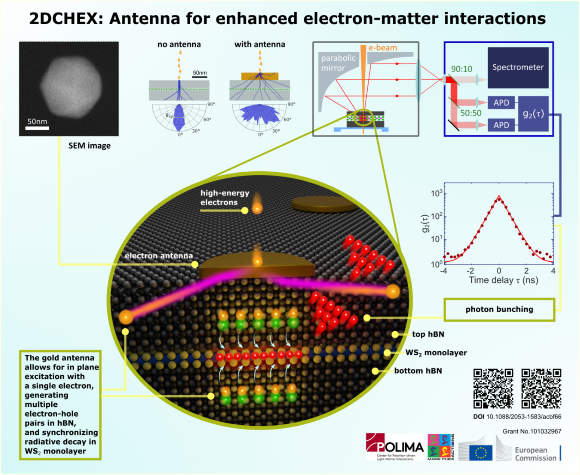
Publications
- Photon superbunching in cathodoluminescence of excitons in WS2 monolayer,Saskia Fiedler, Sergii Morozov, Leonid Iliushyn, Sergejs Boroviks, Martin Thomaschewski, Jianfang Wang, Timothy J Booth, Nicolas Stenger, Christian Wolff, and N Asger Mortensen, 2D Materials 10, 021002 (2023)
- Purifying single photon emission from giant shell CdSe/CdS quantum dots at room temperature, Sergii Morozov, Stefano Vezzoli, Alina Myslovska, Alessio Di Giacomo, N. Asger Mortensen, Iwan Moreels, and Riccardo Sapienza, Nanoscale 15, 1645 (2023)
- Room-Temperature Low-Voltage Control of Excitonic Emission in Transition Metal Dichalcogenide Monolayers, Sergii Morozov, Christian Wolff, and N. Asger Mortensen, Advanced Optimal Materials 9, 2101305 (2021)
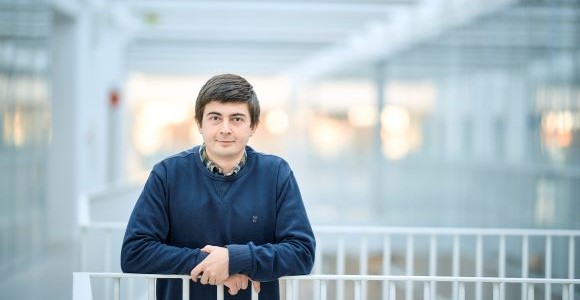
Sergii Morozov is postdoc at the POLIMA Center of Excellence.
2DCHEX has received funding from the European Union’s Horizon 2020 research and innovation programme under grant agreement No 101032967.
